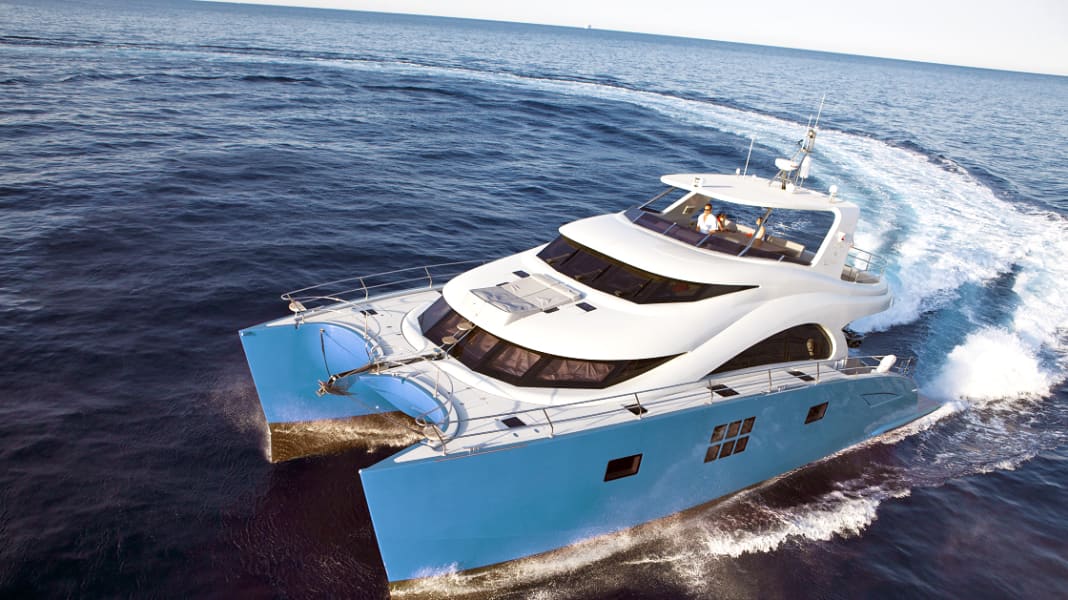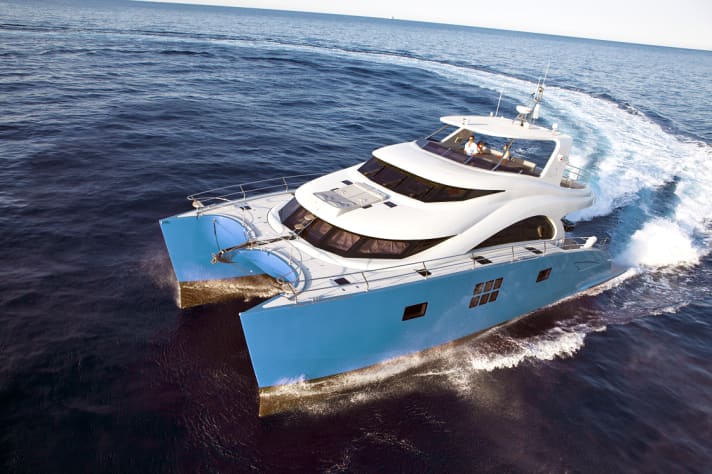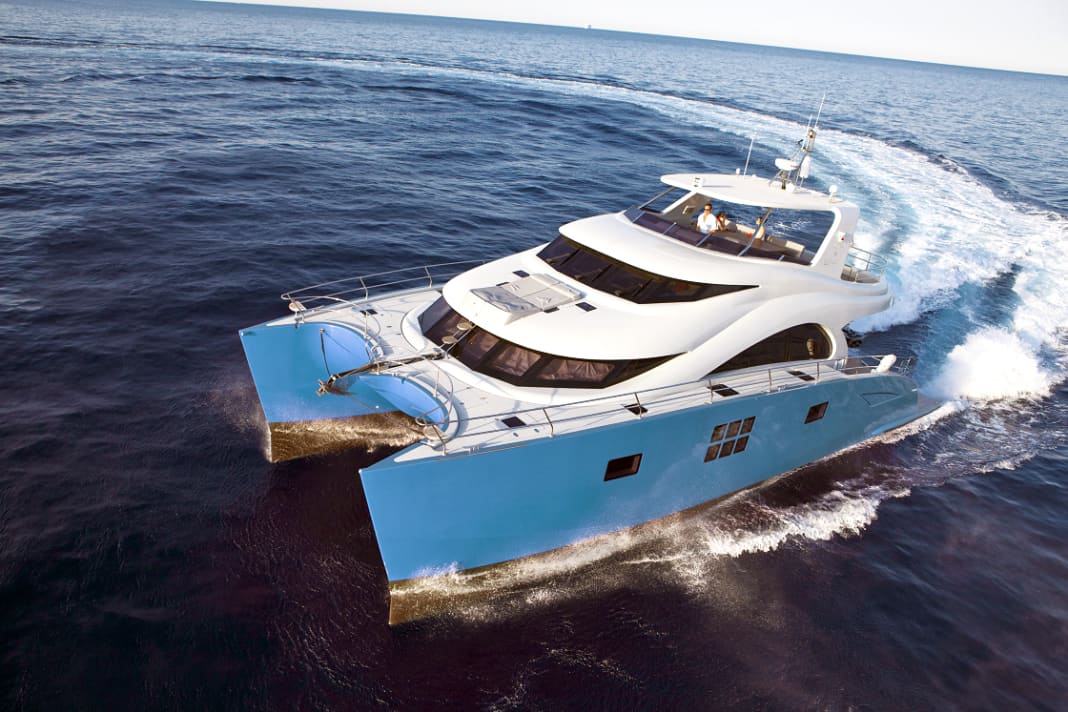







It is actually incomprehensible that twin-hull boats are so rarely found as motor yachts on our waters. Catamarans are generally extremely fast and therefore often the first choice when it comes to top speeds, as in racing. Formula 2 of the Union Internationale Motonautique (UIM) is just one example. XCATS have established themselves internationally. These are "Xtreme Catamarans" from 7.6 to 10 metres in length, which compete in races in many countries. Another remarkable example of high-speed ocean racing is the "Adastra", a futuristic trimaran (tri-hull boat) 42.5 metres long and 16 metres wide.
Is there a market for twin-hull motor yachts in Germany? Catamarans on the market usually have larger dimensions and come from abroad. Motorised catamarans chartered on our lakes and waterways are often relatively heavy and low-powered. Whilst neglecting their sporty character, they are primarily designed to accommodate as many guests as possible.
Successful examples of the use of catamarans are solar-powered boats with electric drives for inland waterways, but also for use at sea. Large panel surfaces and low driving resistance are a must here. The "Turanor PlanetSolar", built in 2010 with a solar cell surface area of 537 square metres, shows what something like this looks like when done right. The catamaran reached a sustained speed of seven knots over long distances with electric motor propulsion alone. The "PlanetSolar" crossed the Atlantic and the South Seas, proving the seaworthiness of machine-driven catamarans at the same time.
In recent years, slow but unfortunately less manoeuvrable platforms with two floats with a length-to-width ratio of almost 1:1 have become widespread on inland waterways. It is not only on the Havel that houseboats or less attractive platforms with a shelter, powered by a low-power outboard motor, are on the move.
Catamaran ferries are no longer a rarity in commercial shipping. They are much faster than conventional monohull boats and consume less energy. In addition, many catamarans or SWATH (Small Waterplane Area Twin Hull) are currently used as workboats due to their high heeling stability and favourable sea behaviour. An interesting example of this is the 25 metre long and 13 metre wide research vessel "Estland".
In sailing, catamarans and trimarans are constantly setting new speed records over long distances at sea. They reach speeds of up to 50 knots. When a 90-foot mega-slull from New Zealand competed against a smaller catamaran from the USA in the America's Cup for the first time in 1988, the inferiority of the monohull was almost embarrassing and caused a sensation.
The most important advantage of the catamaran is the low flow resistance of the individual submerged hulls with a large length-to-width ratio; and this applies in particular to high boat speeds. It is well known that the wave resistance is decisive for the hull speed of a boat. The proportion of wave resistance in the vicinity of the hull speed is around 70 % for a monohull and reaches its maximum at the transition to the planing state. The longer, narrower and slimmer the single hull of the catamaran, the lower the wave resistance. Theoretically, a thin plate pulled through the water would have zero wave resistance!
The ratio of the length to the width of a monohull planing boat is between 2.5 and 3.5. For good planing characteristics, you need wide stern frames with low chine. In contrast to this, values of L : B of up to 15 (!) are achieved for the individual hull or float of the catamaran, which largely minimises the proportion of wave resistance. The displacement of the yacht should be as low as possible. With a few exceptions, catamarans are also used as displacement boats beyond the "hull speed" - which is of secondary importance for catamarans with a very slim underwater hull.
Another advantage of catamarans is that, unlike gliders, the stern is very slender and guarantees a low-drag outflow with little or no separation. Catamaran motor yachts of this type are extremely energy-efficient, even at high speeds.
Of course, limitations in terms of flow resistance should not go unmentioned. The floats of cruising catamarans often need to be "furnished", whereby the choice of a larger waterline width is unavoidable. Although in these cases the wave resistance increases compared to a catamaran with slim floats, the aspect ratio L : B of 8 to 9 is still much more favourable than that of a monohull.
Really heavy catamarans require large-volume floats, which also have a negative effect on resistance. If the displacement of the catamaran and monohull is the same, the surfaces wetted by the water and therefore the proportion of frictional resistance are greater on the catamaran. However, this characteristic is particularly important at low speeds and has only a moderate influence on the energy efficiency of twin-hull motorboats with a smooth underwater hull.
Due to the large overall width of catamarans (L : B ≈ 1.7 to 2.5 : 1), the stability moments increase sharply with increasing heel and prevent larger heeling angles and rolling movements in rough seas. The same applies to the trim. However, it can get really wet on deck at higher speeds. Pitching movements (pitching) cannot always be prevented except when the wave frequency is unfavourable in the opposite direction. A prerequisite for good seaworthiness is that the decks and the beams connecting the hulls provide sufficient clearance to the water surface. Not only "PlanetSolar" and "Adastra", but also many sailing catamarans have proven the seaworthiness of motorised catamarans and trimarans on their spectacular circumnavigations.
While monohull motorboats often stay in the harbour from a wind force of 5 to 6, as violent rolling, pitching and yawing movements of the boat are unavoidable at sea, depending on the direction of the swell, and all accessories are whirled around, the catamaran is largely calm in the sea.
Catamarans have excellent steering behaviour. They run straight ahead as if on rails, as long as the rudders are set to one or two degrees in the starting position, depending on the direction of rotation. There is hardly any yawing or veering off course. However, this means that the turning circle will be larger at full speed compared to a monohull. Whether this is really a significant disadvantage remains to be seen.
On the other hand, catamarans are quite manoeuvrable in the harbour and can turn on the plate. However, the twin-screw drive with two rudders is indispensable for this. The flow of the propeller and rudder behind the slim float could not be better. The result is a very low-vibration drive. The prerequisite for this is that the speed and direction of rotation of the respective propellers can be controlled separately by hand or determined with the aid of a joystick and corresponding programme control for the respective characteristics of a catamaran.
If the catamaran is equipped with very slim, streamlined hulls, the space available in the submerged part of the float is very limited due to the lack of width. Nevertheless, there is still enough space for all units, the propeller drive, tanks and storage compartments.
This is compensated for by huge deck areas. In general, the outer sides of the hulls of cruiser catamarans extend up to deck level, so that the entire width and length of the catamaran can be used for cabins, the driving position and plenty of free space. With an average length-to-width ratio of 2.5 for double-hull boats, this results in a deck area of 40 (!) square metres for a 10-metre-long catamaran. A monohull boat of the same length cannot offer anywhere near this.
The question arises as to why monohull boats are preferred despite the favourable characteristics of catamarans. Firstly, there are the acquisition costs, which are certainly higher compared to monohull boats of the same length and quality. The cost of manufacturing two hulls and the connecting beams is higher. In addition, twin-screw propulsion with two engines is a basic requirement for a good motorised catamaran. On the other hand, the comfort offered on the large deck area is also a good argument in favour of the higher price. Unfortunately, small cruiser catamarans are difficult to realise under these conditions. Another sore point for very wide catamarans is the mooring problem. It is not uncommon for only anchorages to be available for catamarans in harbours.
The outward appearance of catamarans, the overall picture, takes some getting used to and often does not match the elegance of a sleek motor yacht. Perhaps this is the reason why catamarans have become more popular in recent years, especially as workboats and ferries.
Finally, there is another argument in favour of the planing boat rather than the catamaran, which is always a displacement boat. The transition to planing, the lifting of the bow area, the clearly visible bow and then stern wave, the tight turning circle at full throttle - these are all experiences that fast planing boats in particular offer. Wishful thinking that the catamaran cannot fulfil, with a complete disregard for energy efficiency. If you look at the adverts for motor yachts, many are shown at maximum speed. Despite the 30 kn wind speed, a young, scantily clad lady on deck is often a must. Motorboating should be fun.
Perhaps knowledge of the characteristics of catamarans and their qualities can help to improve the image of catamaran motor yachts. If we exclude racing and high-speed boats as well as platforms for houseboats and commercial vessels, the only remaining catamarans are motor yachts of around 10 metres in length. Concepts for smaller catamaran-like motorboats are certainly also conceivable, which, like the monohull, also promise sailing fun. The main advantages of catamarans are their energy efficiency, which is also noticeable at higher speeds, their good seaworthiness and the huge amount of space they offer. On the negative side, the high costs must be mentioned first and foremost.
The elegance of a large monohull motor yacht is currently undisputed. However, as styles and fashions are constantly changing, it cannot be ruled out that catamarans will meet the expectations of an attractive motor yacht in the future and become increasingly popular.

